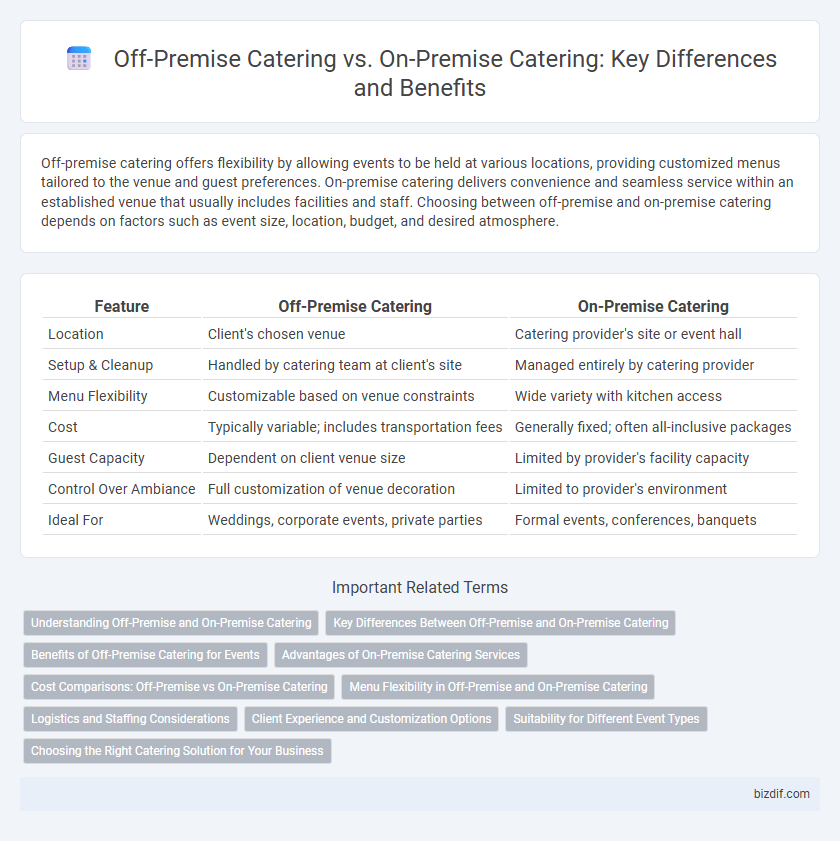Off-premise catering offers flexibility by allowing events to be held at various locations, providing customized menus tailored to the venue and guest preferences. On-premise catering delivers convenience and seamless service within an established venue that usually includes facilities and staff. Choosing between off-premise and on-premise catering depends on factors such as event size, location, budget, and desired atmosphere.
Table of Comparison
| Feature | Off-Premise Catering | On-Premise Catering |
|---|---|---|
| Location | Client's chosen venue | Catering provider's site or event hall |
| Setup & Cleanup | Handled by catering team at client's site | Managed entirely by catering provider |
| Menu Flexibility | Customizable based on venue constraints | Wide variety with kitchen access |
| Cost | Typically variable; includes transportation fees | Generally fixed; often all-inclusive packages |
| Guest Capacity | Dependent on client venue size | Limited by provider's facility capacity |
| Control Over Ambiance | Full customization of venue decoration | Limited to provider's environment |
| Ideal For | Weddings, corporate events, private parties | Formal events, conferences, banquets |
Understanding Off-Premise and On-Premise Catering
Off-premise catering involves providing food services at a location other than the catering company's facility, ideal for events held in homes, parks, or rented venues where setup and transportation logistics are essential. On-premise catering takes place within the catering venue itself, offering controlled environments with built-in kitchen facilities and staff, which allows for streamlined service and enhanced menu customization. Choosing between off-premise and on-premise catering depends on factors such as event size, location flexibility, and desired service style.
Key Differences Between Off-Premise and On-Premise Catering
Off-premise catering is conducted at a location separate from the catering provider's establishment, often at clients' homes, offices, or event venues, offering greater flexibility and customized setups. On-premise catering occurs within the caterer's facility or a fixed event space, providing controlled environments with established kitchens and staff, which often results in streamlined service and consistent quality. Key differences include logistical complexity, cost considerations, and the level of control over the event space and service delivery.
Benefits of Off-Premise Catering for Events
Off-premise catering offers unparalleled flexibility by allowing events to take place at any location, creating customized and memorable experiences. It reduces venue restrictions and often results in lower overall costs, as clients can choose more affordable or meaningful venues. This catering style also streamlines logistics and enhances guest comfort by adapting to the specific needs and preferences of the event setting.
Advantages of On-Premise Catering Services
On-premise catering services offer unparalleled control over event logistics, ensuring timely food preparation and service in a designated venue equipped with necessary facilities. This setup enhances guest experience by providing freshly prepared meals tailored to the event's specific atmosphere and style. Furthermore, on-premise catering allows for seamless coordination with venue staff, resulting in smoother event execution and immediate assistance in addressing any issues.
Cost Comparisons: Off-Premise vs On-Premise Catering
Off-premise catering generally incurs lower venue costs since events are hosted at clients' chosen locations, reducing overhead expenses for caterers. On-premise catering often includes fees for event space rental, equipment, and staffing, resulting in higher overall costs. Clients seeking budget-friendly options typically find off-premise catering more economical due to its flexibility and lower fixed expenses.
Menu Flexibility in Off-Premise and On-Premise Catering
Off-premise catering offers greater menu flexibility, allowing for customized dishes tailored to diverse event locations and guest preferences without kitchen constraints. On-premise catering generally provides a fixed menu that leverages the venue's kitchen facilities, ensuring consistent quality and presentation. Menu adaptation in off-premise catering caters well to dietary restrictions and unique themes, enhancing guest experience.
Logistics and Staffing Considerations
Off-premise catering requires detailed logistics planning to manage transportation, delivery timelines, and equipment setup at remote locations, often demanding a larger, mobile staff trained in adaptability. On-premise catering benefits from fixed kitchens and infrastructure, reducing transit challenges but necessitates coordination with venue schedules and on-site support personnel. Staffing for off-premise events often involves cross-trained team members capable of handling setup, service, and teardown, while on-premise catering may employ specialized roles focused on food preparation and customer service within a controlled environment.
Client Experience and Customization Options
Off-premise catering offers clients flexibility and convenience by allowing events to take place at any chosen location, enhancing personalized atmosphere and client control over setup and timing. On-premise catering provides a more controlled environment with dedicated staff and facilities, ensuring consistent service quality and immediate access to kitchen resources. Customization options in off-premise catering often include varied menu choices tailored to venue constraints, while on-premise catering can deliver extensive customization through specialized equipment and curated event packages.
Suitability for Different Event Types
Off-premise catering is ideal for large, outdoor, or unconventional venues where flexibility and space are priorities, such as weddings, festivals, and corporate picnics. On-premise catering suits formal events held within hotels, banquet halls, or restaurants, offering controlled environments with built-in amenities for fine dining experiences. Event planners choose based on event size, location, and desired atmosphere to ensure seamless food service and guest satisfaction.
Choosing the Right Catering Solution for Your Business
Off-premise catering offers flexibility by allowing businesses to host events at various locations, making it ideal for outdoor functions or venues without kitchen facilities. On-premise catering provides greater control over menu customization, service quality, and ensures consistent brand experience since food is prepared and served at the business location. Selecting the right catering solution depends on factors like event type, guest count, budget, and the desired logistical convenience, ensuring optimal client satisfaction and operational efficiency.
Off-Premise Catering vs On-Premise Catering Infographic

 bizdif.com
bizdif.com